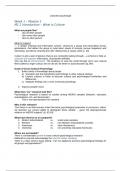Culturele psychologie
Week 1 – Module 1
M1.1 introduction – What is Culture
What are people like?
- Like all other people
- Like some other people
- Like no other person
What is Culture?
“... a unique meaning and information system, shared by a group and transmitted across
generations, that allows the group to meet basic needs of survival, pursue happiness and
well-being, and derive meaning from life” (Matsumoto & Juang, 2023, p. 16)
Culture is also a pair of glasses that we are constantly looking through – a schema to help us
evaluate and organize information. (functionele definitie)
This can link to ethnocentrism: The tendency to view the world through one’s own cultural
filters (alleen je eigen cultuur zien en die als ‘de beste’ te aanschouwen) (p.344)
Goals of Cross-Cultural Psychology
1. Build a body of knowledge about people
a) Transport and test hypotheses and findings to other cultural settings
b) Explore cultures in order to discover cultural and psychological similarities and
differences
c) Integrate findings into a more universal psychology
2. Improve people’s lives.
What does ‘our’ research look like?
Psychological research is based on studies among WEIRD samples (Western, educated,
industrialized, rich, and democratic)
- This is not representative for mankind
Why is this relevant?
“Our thesis is not that humans share few basic psychological properties or processes; rather,
we question our current ability to distinguish these reliably ... given the disproportionate
reliance on WEIRD subjects” (p. 62-63).
What have Henrich et al compared?
1. Modern industrialized vs. small scale societies
2. Western vs. non-Western industrialized societies
3. Americans vs. other Westerners
4. University vs. non-university educated Americans
Where are we headed?
There is considerable growth in cross-cultural psychological research.
Editorials in journals acknowledge the need for better sampling.
There is a clear need to keep asking: “Can we apply/use previous psychological findings for
all groups and populations?”
,How does Culture develop?
Origins of Culture
Environment comes with demands for adaptation
- Climate
- Resources
- Population density
- Environmental stressors (operationalized as distance from equator) (bv. geld)
- Affluence
What are theoretical approaches to understanding cultural differences and similarities?
Different greetings across cultures…why?
1. Absolutism – psychology is everywhere the same
2. Relativism – underlying processes are different
3. Universalism – underlying processes are the same, expressions may be different
Key terms:
Etics: Universal psychological processes or behavior
Emics: Culture-specific processes or behavior
Society = a system or a structure of inter relationships among individuals and groups
Culture = the meaning/value that we are associating with those structures and relationships
to other people
Race =
More of a social construction than a biological essential (p.20)
Culture provides race its meaning:
Racial differences are not useful for scientific or practical purposes without a clear
understanding of the underlying causes of the similarities and differences observed
Ethnicity =
Groups characterized by a common nationality, geographic origin, culture, or language.
Ethnicity is not the same as race, it is more connected to culture.
Different discourses in Europe vs US
Week 1 – Module 1
M1.2 – Content of Culture
Objective elements – things that you can observe
• Art
• Mass media
• Architecture
• Clothes
• Social media
• Food
• Music
• Advertising
• Eating utensils
• Texts
Subjective elements – things that are more internal to
people
,Values
Hofstede’s cultural values – Individualism/Collectivism
• Most cited general framework to classify cultural patterns on the country level
• Examination of work related values in employees of IBM during the 1970s (Hofstede, 1981)
• Four (classic) dimensions
1. power distance
2. individualism / collectivism
3. masculinity / femininity
4. uncertainty avoidance
• Now 6 (after 2010)
5. Long-term/short-term orientation
6. Indulgence
Individualism/Collectivism =
The degree to which groups will encourage tendencies for members to look after themselves
and their immediate family only, or for them to belong to in- groups that look after its
members in exchange for loyalty.
Criticism:
• Widely criticized both for substantial and methodological reasons
• More on the theory and criticism in Chapter 15 on organizations
Example of Individualism/Collectivism in psychology:
Worldviews: Markus & Kitayama’s independent and interdependent self
Worldviews
Concepts: Independence and Interdependence – Markus and Kitayama (1991)
The self as the mediator of individualist/collectivist cultural differences: its construal differs
across cultures
Independent self-Interdependent self – collectivist
Beliefs
Bond & Leung’s social axioms
Social axioms = General beliefs and premises about oneself, the social and physical
environments, and the spiritual world; they are assertions about the association between two
or more entities or concepts.
Nations as a Function of Their Dynamic Externality and
Societal Cynicism
Zie PP voor beter plaatje
, Dynamic Externality =
Beliefs concerning external forces such as fate, a supreme being, and spirituality.
Bv. “Belief in a religion helps one understand the meaning of life” and “good deeds will be
rewarded, and bad deeds will be punished”
Societal Cynicism =
An apprehension or pessimism of the world.
Bv. “Caring about societal affairs only brings trouble upon oneself” and “kind-hearted people
usually suffer losses”
Norms
Gelfand’s tightness-looseness
Tight: Strong norms, low tolerance for deviant behavior Zie PP voor schema’s etc.!
Loose: Weak norms, high tolerance for deviant behavior
Week 1 – Module 2
M2.1 – Methods in Cross/cultural Research
Types of studies
Exploratory studies: Examines the existence of cross-cultural similarities or differences
- Strength - Broad scope for identifying similarities and differences
- Weakness - Limited capability to solve the causes of differences
(Dus goed voor ontdekken, niet voor écht testen)
Hypothesis-testing studies: Examines why cultural differences exist, helping to explain things
- Inferences promote cross-cultural biases and in equivalence
What are we looking for?
Structure-oriented studies: Comparison of a culture’s constructs, structures, or relationships
among constructs with those of another culture
Level oriented studies: Comparison of mean levels of scores between cultures
At what level are we doing research?
Individual-level studies: Individual participants provide data and are the unit of analysis
Ecological (cultural) studies: Countries or cultures are the units of analysis (bv. Hofstede)
Multilevel studies: Involve data collection at multiple levels of analysis
Distinguishing – Levels is important
Isomorphism is not a given: relations between variables may not be the same at different
levels.
Bv.
Think about the question: what is the relation between obesity and health (e.g., longevity)?
‘Obesity at the individual level is negatively related to health, you were correct. This means
that being overweight comes with a lot of health risks – a very well-established finding.
But this is NOT the same for the relationship between obesity and health at the national
level.’
The Simpsons Paradox
National level = red line = positive
Individual = negative





